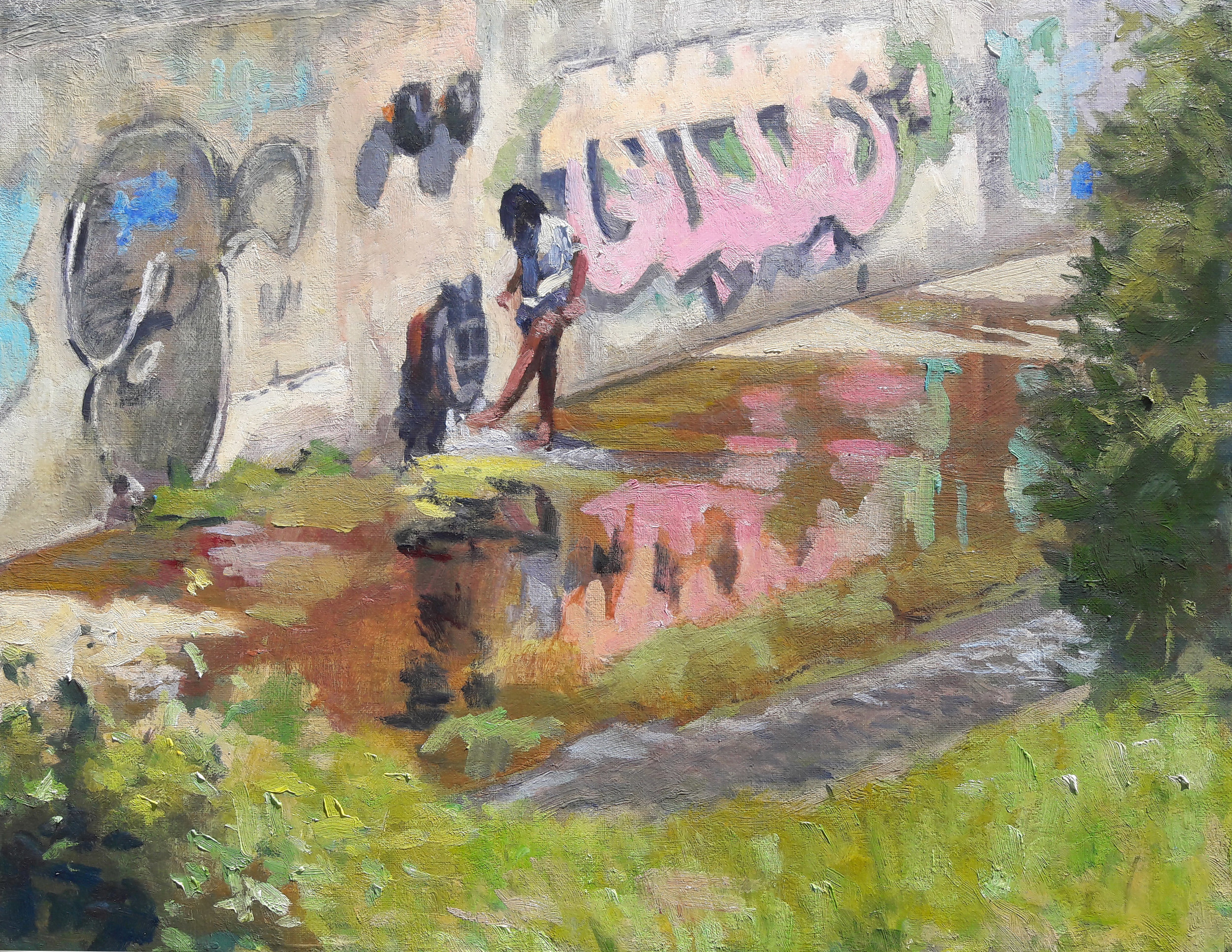Spillway Girl Revisited, Part One
This past February when I prepared to spend six weeks in Charleston, SC, I did lunch with Carl Samson and Richard Luschek, and shared my objectives for the pictures I intended to paint in the Low Country and afterward.
There were three. I wanted to work larger, I wanted to solve all drawing problems in advance of beginning to paint, and I wanted figures in my pictures.
Carl stopped me at that last one. "No, you don't want figures. You want meaningful figures."
This is why it pays to have friends, and particularly, friends who've already walked the path you intend to tread. The first Charleston picture I finished paid homage to all three of my stated objectives, but not to Carl's caveat. Here's an oil sketch of the picture's star. It took me fifteen minutes, and was far more satisfying than the finished picture itself.
This was to be my Texting Woman opus. I persuaded a local woman to pose for me, and did this rapid sketch. For some time I've wanted to do a picture of someone sending a text message while traipsing through an idyllic landscape. This was my chance. I did all of the things I'd intended: worked large, had a figure, and in the course of doing several sketches like this one, tried my best to solve all drawing problems in advance.
But it was a scene which I could never get excited about. I'm not sure why not. The tree and roadway had been studied and sketched at length. It should have worked, but it did not. The figure was meaningful enough, but the whole scene wasn't. Maybe I was in a hurry. It wasn't all that interesting a scene; mostly it was convenient. And it takes time to find an area's great motifs, the ones which beg to be painted. I had my sketch of the woman. I could have waited till I found the appropriate country road for her to ignore. But I didn't. Haste makes waste.
I guess another factor is the time of year. Summer and fall are times that seem given to good pictures; they're punched up with color. Late winter and early spring are desolate by comparison. Where's the pictorial irony of a woman ignoring a desolate landscape in favor of her smartphone? Honestly, who could blame her?
Later I did find plenty of meaningful vistas in Charleston and did some good pictures there, but this one ain't one of 'em.
Fast forward to June, when after putting in four sessions on a view of the Duck Creek Spillway, I spied a young woman wandering through the trench and prevailed on her to pose. The result was Carl Samson's "meaningful" figure. She turned an unfocused urban landscape picture into a genre piece.
It was a nice little picture, worth its five sessions (or approximately fifteen hours) or work. but little pictures weren't my objective. I wanted bigger, fully realized compositions, and my Spillway Girl seemed worth a more monumental treatment.
The model was willing to give me a shot. We exchanged phone numbers, and I stretched a much larger canvas.
So in early July, the woman and I rendezvoused at the spillway, me with a larger canvas and she with a giving heart. The truncated cone structure in the center of this snapshot is the foliage-laden object in the foreground of the earlier picture. In between that pic's completion and this one's beginning, they'd done some trimming on my side of the spillway.
This was Day One. I think the best one can hope for on the first day is to cover the canvas, to give yourself a pictorial environment in which decisions can be evaluated and, if necessary, corrected. I got the canvas covered.
It is helpful to not build up huge mounds of paint while outlines are still being figured out. This picture got scraped down a few hours after the end of each session. The alternative is silly. If paint is built up along a sitter's outline, this leaves you with no opportunity to adjust that outline, or lose it altogether. Ernest Hemingway famously said that if you removed all of the pretty words from a passage and it still had some punch, then you had a good passage. The same is true of hard outlines and a buildup of paint, at least at the beginning. Such elements are a tool, but a tool not to be used until pretty much everything is figured out.
At Day One, my story was, in ascending order, about three things: pavement soaked with water from the sluice gate, graffiti, and the woman washing her feet. In terms of physical area, the pavement was the largest, the graffiti the second largest, and the woman the smallest. In terms of focus, the pavement wanted the least, the graffiti the medium, and the woman the most. The plan was to provide the viewer's eye with a large surface to contemplate and wander around in, but to leave that viewer no option other than to return to the woman. There are such things as ensemble movies, like Robert Altman's Nashville, or Tarantino's Reservoir Dogs, or Parenthood or The Best Years of Our Lives. But like most films you love the most, this painting was not to be an ensemble. My Spillway Girl was to be the one and only star.
Whether or not that was a good plan, it was the plan, and in the eleven subsequent sessions, that plan was never changed. Day One was the picture's melody, and I was satisfied with it. For the next couple of weeks, I would be tasked with tweaking its instrumentation and arrangement. But the melody never changed. I think time proved that it was a good melody.




